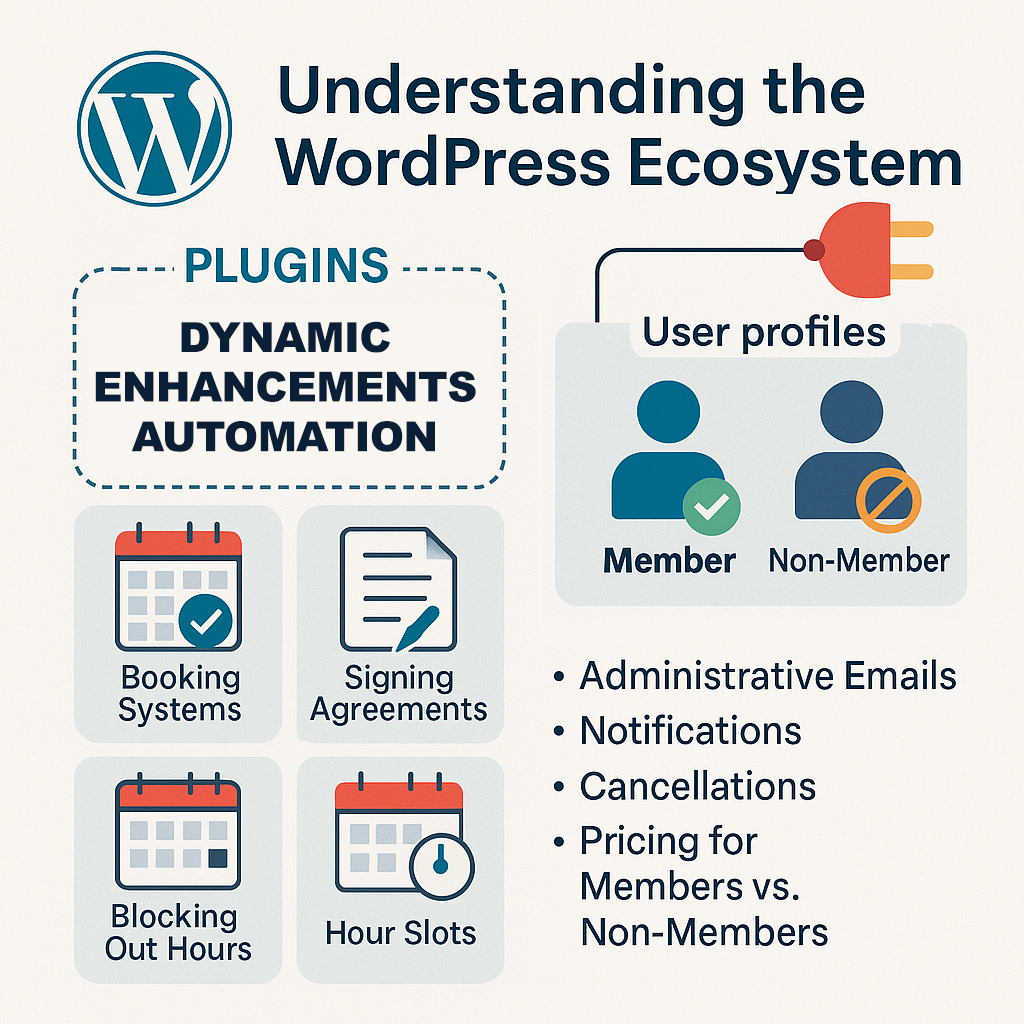When most businesses think about launching a website, the conversation often starts with “just put something simple together.” But in reality, “simple” is rarely simple—especially once you factor in real-world needs like automation, member management, payments, and scheduling–just to name a few enhancements. The WordPress ecosystem is powerful, flexible, and proven, but understanding how plugins and integrations work together is essential before making big decisions.
The WordPress Ecosystem
WordPress powers over 40% of the web because of its adaptability. At its core, WordPress provides the foundation: a content management system (CMS) that can be extended with plugins and themes. Plugins allow you to add functionality—everything from SEO optimization and forms to e-commerce and booking systems.
However, the more complex your needs, the more critical it becomes to understand how plugins interact with each other. One plugin may handle payments. Another may manage bookings. A third may provide memberships. But do they talk to each other? Can they enforce the rules of your business consistently across the site? That’s where things become complicated.
Automation and Dynamic Enhancements
A modern business website often requires much more than a brochure. Businesses want automation:
-
Booking Systems – Clients can see available time slots, book appointments, and pay in advance.
-
Payment Terms – Deposits, balances, recurring subscriptions, or member discounts.
-
Contracts & Agreements – E-signatures and confirmations built into the booking process.
-
Notifications & Admin Tools – Automated emails, cancellations, rescheduling, and reminders.
These aren’t just “nice to have” features. They save time, reduce administrative errors, and set expectations with customers.
Manual vs. Automated Systems
Another decision point is whether to stick with manual data entry or move to automation. A calendar widget might show appointments, but if you have to enter each booking manually, it’s not saving you much time. On the other hand, fully automated booking and payment systems require greater investment—both in setup and ongoing licensing costs.
Switching to automation only makes sense once your business volume justifies the expense. A fully closed ecosystem—where everything from booking to payment to notifications happens under one roof—can be powerful, but it’s rarely cheap. The cost is not just in software, but in setup, customization, and ongoing support.
What About Pricing Models?
The Member vs. Non-Member Challenge — how do you determine who is engaging if you wish to provide different pricing structures for different users.
One of the most overlooked complications in web development is pricing for members versus non-members (or many cases, guest users that do not have a user profile or login to your system but still want to buy). A business may want to charge the public one rate, while members (with logins or paid subscriptions) see another. But that single request triggers a long list of requirements:
-
User profiles and login systems
-
Password resets and account recovery
-
Payment gateways that validate membership status
-
Conditional rules to show member pricing only to authorized users
-
Renewal tracking and expiration logic
This is where business owners quickly realize it’s not as simple as using one plugin for bookings and another for payments. Each plugin has to share data, follow consistent rules, and work together without breaking the site.
The Bottom Line
WordPress offers nearly unlimited flexibility, but building the right solution takes planning. It’s not about installing “just one plugin.” It’s about creating an ecosystem where booking, payments, memberships, and automation work together seamlessly. Businesses need to evaluate where they are today, what their real needs are, and whether the numbers support moving into full automation.
Done right, the WordPress ecosystem can take a business far beyond a static website—it can become the backbone of scheduling, payments, membership, and communication. But like any powerful system, it requires careful planning, smart integration, and a clear understanding of the long-term costs and benefits.





